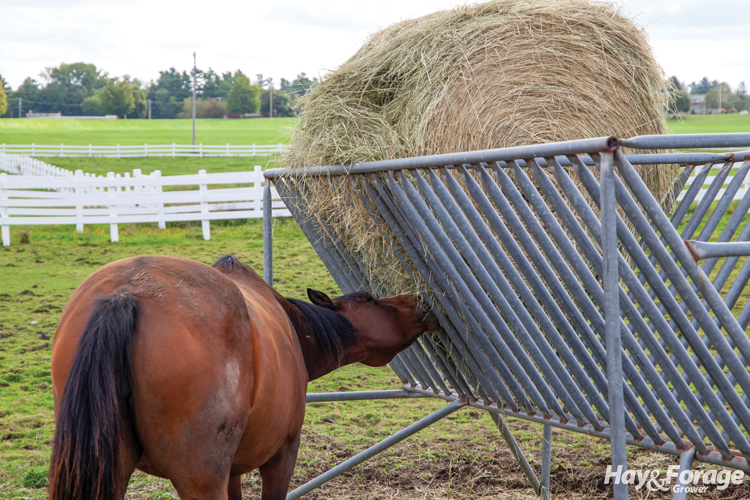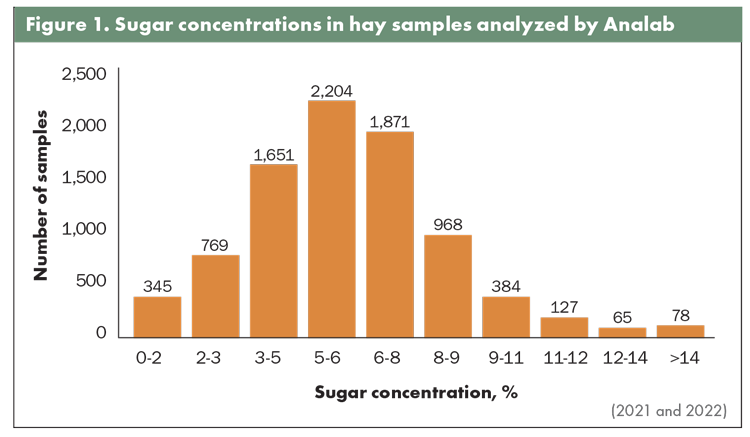
Forage should make up the majority of any horse diet, typically around 1% to 2% of body weight. For example, a 1,000-pound horse consuming 1.5% of its weight in forage will eat 15 pounds of hay per day. The quality and nutrient content of the hay plays an important role in meeting a horse’s nutrient requirements. Horses with metabolic issues, such as equine metabolic syndrome (EMS) and insulin resistance (IR), require special dietary considerations to maintain their health and well-being.
In horses with insulin resistance, much like type 2 diabetes in humans, circulating blood glucose concentration is high due to excess dietary sugar and starch. This high insulin concentration persists because the body’s cells do not respond to the insulin and therefore cannot transport the glucose from the blood to the cells. Insulin resistance can be involved in laminitis due to the decreased blood flow to the hoof and impaired glucose uptake.
Maintaining the health of horses with metabolic problems is a challenging, yet essential, task for equine owners and caregivers. Focusing on the production and management of hay can have a significant impact on the well-being of these horses. By following the best practices outlined in this article, such as selecting appropriate hay types, harvesting at the right stage, managing sugar content, and performing nutrient analysis, horse owners can provide a safer and more suitable diet for their animals. However, it’s essential to remember that individual horse needs may vary, and consulting with an equine nutrition expert is highly recommended for tailoring the diet to each horse’s unique needs.
Select the right hay
Choosing the right hay type is crucial to meet the nutrient requirements of your horse. Metabolically challenged horses require special attention to what makes up their total diet and often are fed “low carbohydrate feed.” Nonstructural carbohydrates, or NSC, is a term used to refer to the total sugar and starch in a feed. Typically, hay below 12% NSC is ideal for horses prone to metabolic problems.
Cool-season grass hays such as timothy and orchardgrass are generally higher in NSC than warm-season grasses such as bermudagrass and teff grass. Ryegrass, a cool-season perennial, is one that can have higher NSC concentrations than others; therefore, it may not be the best choice for horses prone to metabolic issues. Hay made from small grains like oats, triticale, and barley are often high in NSC as they potentially contain seedheads. Alfalfa can be low in sugar and is higher in digestible energy and protein. However, despite alfalfa being lower in NSC, its energy density may be in excess of what most horses need.
There are many factors that contribute to the NSC content of hay, including plant cultivar, maturity at harvest, time of cutting, and cure time.
Time harvest for low NSC
The stage of maturity during hay harvesting significantly impacts its nutritional value. Young plants tend to be higher in sugar and very mature plants can be unpalatable, so it is best to aim for mid-bloom grass.
Sunlight will also lead to sugar accumulation in the plant as the plant is photosynthesizing, so it is recommended to cut hay in the morning. On a foggy or cloudy day, sugar will also be lower. Furthermore, the longer the hay is dried in the field, the lower the NSC content.
If hay has been lightly rained on, it will have lower NSC content, but care must be taken to ensure it is completely dried when baled. Other environmental factors such as drought stress or frost can also raise the concentration of NSC.
Certain haymaking practices can impact the sugar content in hay, such as tedding. Tedding increases the hay’s surface area, expediting the drying process and reducing sugar concentrations.
Soaking hay in water can be an effective method to leach out excess sugars. Submerging hay in water for 30 minutes to two hours can significantly reduce sugar content, making it safer for horses with metabolic issues. Research has shown that soaking hay for 60 minutes resulted in an average 30% reduction in NSC content; however, it’s essential to drain and discard the soaking water and recognize that some minerals may be lost in the soaking process as well.
Test — don’t guess
Regularly analyzing the nutrient content of hay is vital for horses with metabolic issues. While visually assessing the forage can be helpful for observing moldy or dusty hay, or if it contains foreign objects, conduct a more comprehensive analysis using a reputable laboratory. Figure 1 illustrates the variation in sugar concentration that can exist from one hay sample to another. Consider sending your samples in when you get a new load of hay if you notice a change in the look of your hay, or just to make data-driven purchasing decisions.

Performing a laboratory analysis will provide accurate data on sugar, starch, protein, and minerals. This information helps horse owners and managers make informed decisions about feeding and supplementing their horses’ diets. Consult with an equine nutritionist to interpret your hay analysis and to tailor the horse’s diet to its specific needs.
This article appeared in the February 2024 issue of Hay & Forage Grower on pages 26-27.
Not a subscriber? Click to get the print magazine.

